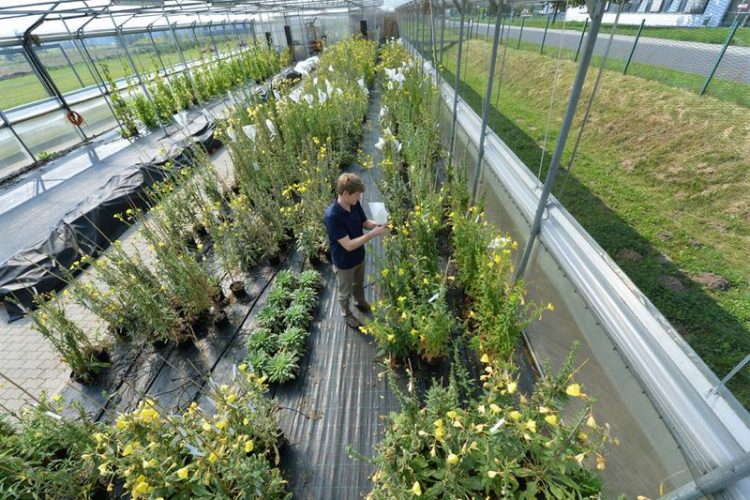The inner struggle of the evening primrose: Chloroplasts are caught up in an evolutionary arms race

Chloroplast research in the evening primrose in the summer foil greenhouse at the MPI-MP. David Ausserhofer
Inheritance is a complex issue. Which genes came from the mother and which were inherited from the father? It is certain that mother and father each inherit 50 percent of their genetic material, both in plants, as well as in animals and humans.
However, that is not all, because in addition to the actual genome in the cell nucleus, there are also organelles that have their own, small genome. These include the mitochondria and, in the case of plants, the chloroplasts additionally. These organelles are normally passed on exclusively from the mother to the offspring, although there are exceptions.
One such exception is the evening primrose, a plant native to America and introduced to Europe in the 17th century. Today, it is an integral part of the Central European flora.
In plant research, the evening primrose is a popular model plant when it comes to the research of organelle inheritance, because both parents of the evening primrose can inherit the chloroplast genetic material to their offspring. But this can result in problems because it is known that the maternal and paternal organelles compete with each other. They cannot co-exist in the offspring as they compete for cellular resources, so one variant must prevail.
But how do chloroplasts fight out this battle? This question could not be answered for a long time. The research team of Stephan Greiner at the MPI-MP and colleagues from Canada, Poland and the USA have uncovered this secret in their current study.
They were able to show that the fatty acid metabolism is decisively responsible for which chloroplast is superior to the other. “Most surprising for us was the discovery that the “fight” between the chloroplast genomes is not decided directly at the gene level, i.e. in the genetic material itself, but that the metabolism plays an important role here,” states Stephan Greiner.
Among others, the research team identified an enzyme that catalyzes the first and thus limiting step in fatty acid metabolism. In their analyzes, the researchers found that the gene responsible for the synthesis of this enzyme is undergoing rapid evolution. These rapid changes enable an arms race between the paternal and maternal chloroplasts. They result in mutations that can lead to improved properties of the chloroplasts. An altered fatty acid synthesis could e.g. change the composition of the chloroplast shell, which can be an advantage.
The findings of the researchers help to understand the mechanisms of evolution in more detail. In fact, great competition between maternal and paternal chloroplasts can result in a non-viable progeny. In this case, the parent plants are incompatible. With the knowledge of the mechanisms behind, it would be quite conceivable that one can overcome such limits and in future would be able to make novel crossings, e.g. to breed more productive or resilient crops.
Dr. Stephan Greiner
Max Planck Institute of Molecular Plant Physiology
Tel. 0331/567 8349
greiner@mpimp-golm.mpg.de
Johanna Sobanski, Patrick Giavalisco, Axel Fischer, Julia M. Kreiner, Dirk Walther, Mark Aurel Schöttler, Tommaso Pellizzer, Hieronim Golczyk, Toshihiro Obata, Ralph Bock, Barbara B. Sears and Stephan Greiner
Chloroplast competition is controlled by lipid biosynthesis in evening primroses
PNAS, 04.03.2019, https://doi.org/10.1073/pnas.1811661116
https://www.mpimp-golm.mpg.de/2279428/der-innerliche-kampf-der-nachtkerze
Media Contact
All latest news from the category: Agricultural and Forestry Science
Newest articles

Silicon Carbide Innovation Alliance to drive industrial-scale semiconductor work
Known for its ability to withstand extreme environments and high voltages, silicon carbide (SiC) is a semiconducting material made up of silicon and carbon atoms arranged into crystals that is…

New SPECT/CT technique shows impressive biomarker identification
…offers increased access for prostate cancer patients. A novel SPECT/CT acquisition method can accurately detect radiopharmaceutical biodistribution in a convenient manner for prostate cancer patients, opening the door for more…

How 3D printers can give robots a soft touch
Soft skin coverings and touch sensors have emerged as a promising feature for robots that are both safer and more intuitive for human interaction, but they are expensive and difficult…





















